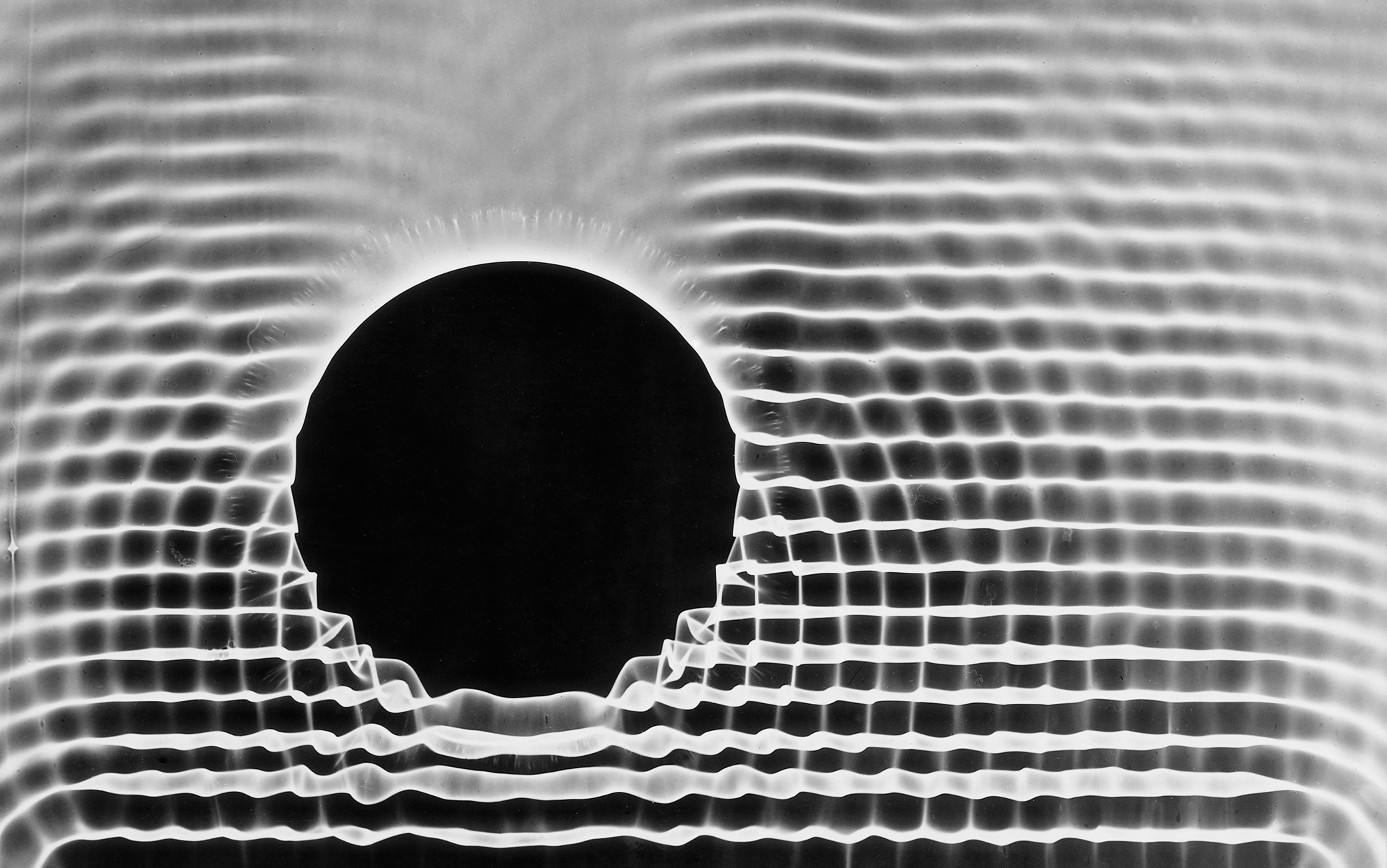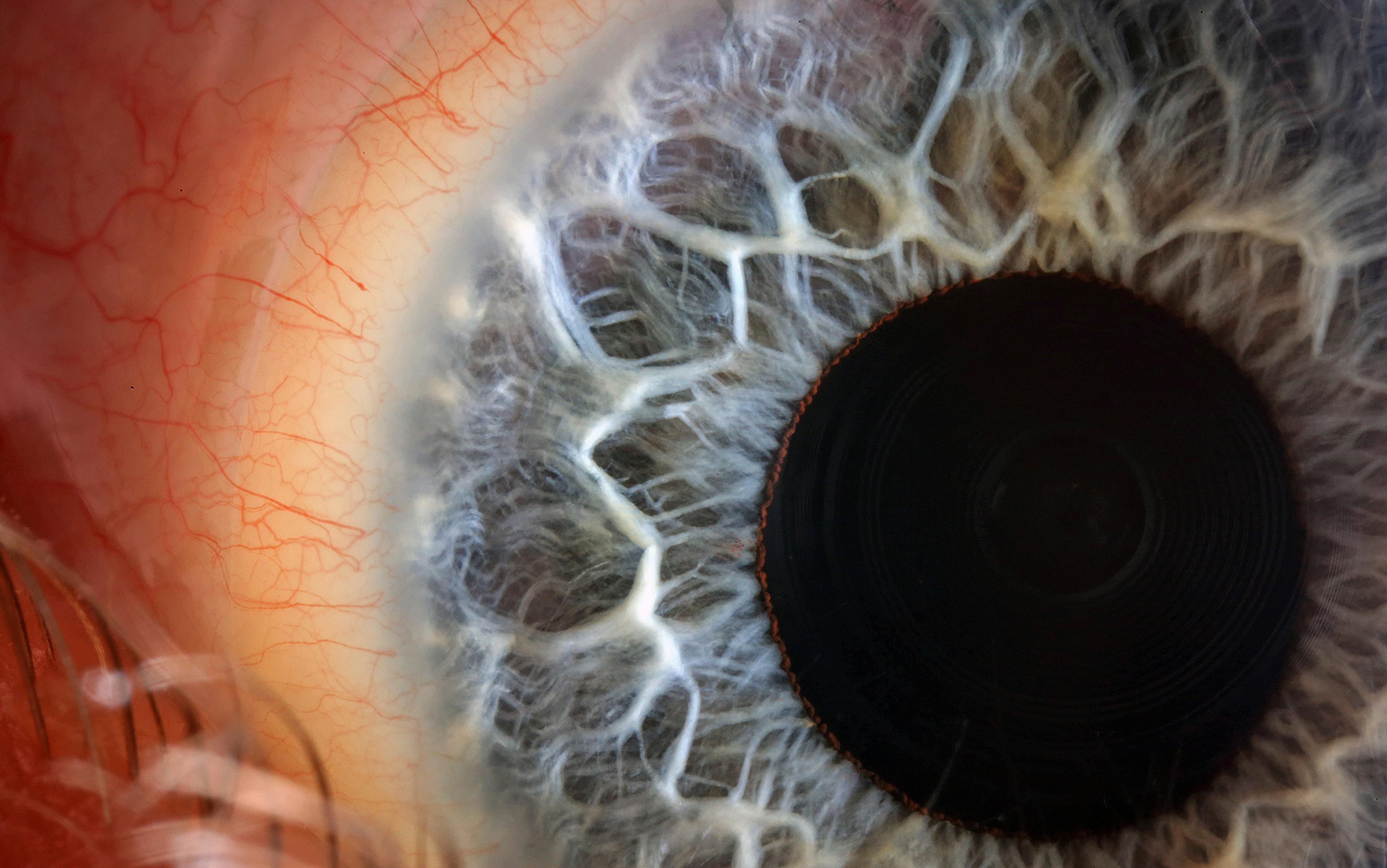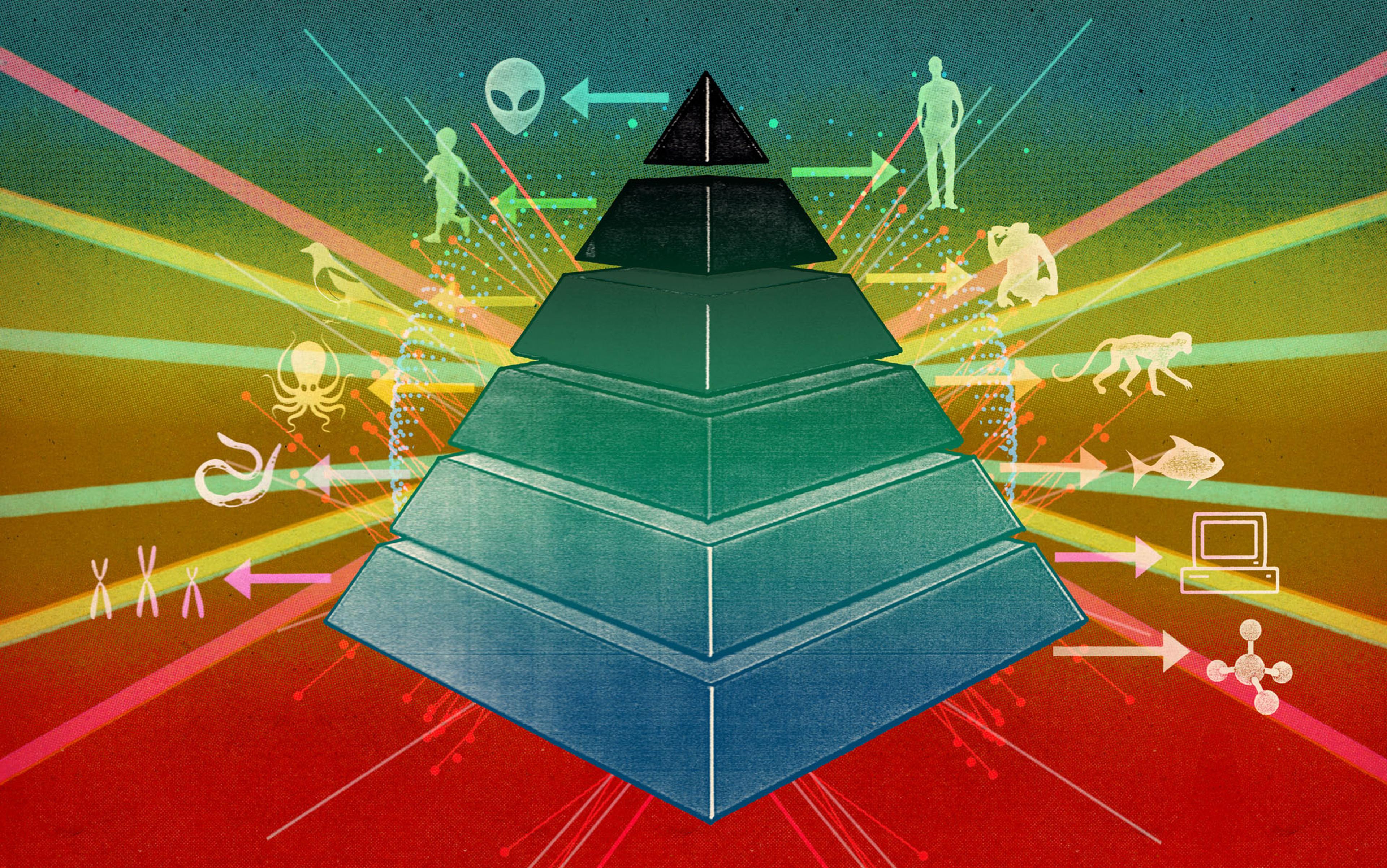Some 2,700 years ago in the ancient city of Sam’al, in what is now modern Turkey, an elderly servant of the king sits in a corner of his house and contemplates the nature of his soul. His name is Katumuwa. He stares at a basalt stele made for him, featuring his own graven portrait together with an inscription in ancient Aramaic. It instructs his family, when he dies, to celebrate ‘a feast at this chamber: a bull for Hadad harpatalli and a ram for Nik-arawas of the hunters and a ram for Shamash, and a ram for Hadad of the vineyards, and a ram for Kubaba, and a ram for my soul that is in this stele.’ Katumuwa believed that he had built a durable stone receptacle for his soul after death. This stele might be one of the earliest written records of dualism: the belief that our conscious mind is located in an immaterial soul or spirit, distinct from the matter of the body.

The Katamuwa Stele cast, digitally rendered by Travis Saul. Courtesy of the Oriental Institute of the University of Chicago.
More than 2 millennia later, I was also contemplating the nature of the soul, as my son lay propped up on a hospital gurney. He was undertaking an electroencephalogram (EEG), a test that detects electrical activity in the brain, for a condition that fortunately turned out to be benign. As I watched the irregular wavy lines march across the screen, with spikes provoked by his perceptions of events such as the banging of a door, I wondered at the nature of the consciousness that generated those signals.
Just how do the atoms and molecules that make up the neurons in our brain – not so different to the bits of matter in Katumwa’s inert stele or the steel barriers on my son’s hospital bed – manage to generate human awareness and the power of thought? In answering that longstanding question, most neurobiologists today would point to the information-processing performed by brain neurons. For both Katumuwa and my son, this would begin as soon as light and sound reached their eyes and ears, stimulating their neurons to fire in response to different aspects of their environment. For Katumuwa, perhaps, this might have been the pinecone or comb that his likeness was holding on the stele; for my son, the beeps from the machine or the movement of the clock on the wall.
Each ‘firing’ event involves the movement of electrically charged atoms called ions in and out of the neurons. That movement triggers a kind of chain reaction that travels from one nerve cell to another via logical rules, roughly analogous to the AND, OR and NOT Boolean operations performed by today’s computer gates, in order to generate outputs such as speech. So, within milliseconds of him glancing at his stele, the firing rate of millions of neurons in Katumuwa’s brain correlated with thousands of visual features of the stele and its context in the room. In this sense of correlating with, those brain neurons would supposedly know at least some aspects of Katumuwa’s stele.
Yet information-processing clearly isn’t sufficient for conscious knowing. Computers process lots of information yet have not exhibited the slightest spark of consciousness. Several decades ago, in an essay exploring the phenomenology of consciousness, the philosopher Thomas Nagel asked us to imagine what it’s like to be a bat. This feature of being-like-something, of having a perspective on the world, captures something about what it means to be a truly conscious ‘knower’. In that hospital room watching my son’s EEG, I wondered what it was like to be one of his neurons, processing the information registering the slamming of a door. As far as we can tell, an individual neuron knows just one thing – its firing rate. It fires or doesn’t fire based on its inputs, so the information it carries is pretty much equivalent to the zero or one of binary computer language. It thereby encodes just a single bit of information. The value of that bit, whether a zero or a one, might correlate with the slamming of a door, but it says nothing about the door’s shape, its colour, its use as a portal between rooms or the noise of its slamming – all features that I’m sure were part of my son’s conscious experience. I concluded that being a single neuron in my son’s brain would not feel like anything.
Of course, you could argue, as neurobiologists usually do, that although a single neuron might know next to nothing, the collection of 100 billion neurons in my son’s brain knew everything in his mind and would thereby feel like something. But this explanation bumps into what’s known as the binding problem, which asks how all the information in millions of widely distributed neurons in the brain come together to create a single complex yet unified conscious perception of, say, a room or a stele. Another issue is one of omission. Why don’t you know anything about the complex network of informational inputs and processing events between immune cells that decide what kind of immune response your body will deploy to protect you from infection? Why hadn’t Katumuwa been aware of the highly complex computations needed to keep himself upright while walking across his room? Why didn’t Deep Blue’s electronic brain maintain an interest in chess? The puzzle is to understand what is special about some, but not all, brain activity that confers awareness and thought but is absent from artificial brains.
Watching those wiggly lines march across the EEG screen gave me the germ of a different idea, something that didn’t boil down to pure neuronal computation or information-processing. Every time a neuron fires, along with the matter-based signal that travels down its wire-like nerve fibre, it also projects a tiny electromagnetic (EM) pulse into the surrounding space, rather like the signal from your phone when you send a text. So when my son heard the door close, as well as triggering the firing of billions of nerves, its slamming would have projected billions of tiny pulses of electromagnetic energy into his brain. These pulses flow into each other to generate a kind of pool of EM energy that’s called an electromagnetic field – something that neurobiologists have neglected when probing the nature of consciousness.
Neurobiologists have known about the brain’s EM field for more than a century but have nearly always dismissed it as having no more relevance to its workings than the exhaust of a car has to its steering. Yet, since information is just correlation, I knew that the underlying brain EM field tremors that generated the spikes on the EEG screen knew the slamming of the hospital room door, just as much as the neurons whose firing generated those tremors. However, I also had enough physics to know that there was a crucial difference between a million scattered neurons firing and the EM field generated by their firing. The information encoded by the million discrete bits of information in a million scattered neurons is physically unified within a single brain EM field.
It is a scientific dualism based on the difference between matter and energy, rather than matter and spirit
The unity of EM fields is apparent whenever you use wifi. Perhaps you’re streaming a radio documentary about Katumuwa’s stele on your phone while another family member is watching a movie, and another is listening to streamed music. Remarkably, all this information, whether movies, pictures, messages or music, is instantly available to be downloaded from any point in the vicinity of your router. This is because – unlike the information encoded in discrete units of matter such as computer gates or neurons – EM field information is encoded as immaterial waves that travel at the speed of light from their source to their receiver. Between source and receiver, all those waves encoding different messages overlap and intermingle to become a single EM field of physically bound information with as much unity as a single photon or electron, and which can be downloaded from any point in the field. The field, and everything encoded in it, is everywhere. While watching my son’s EEG marching across the screen, I wondered what it was like to be his brain’s EM field pulsing with physically bound information correlating with all of his sense perceptions. I guessed it would feel a lot like him.
Locating consciousness in the brain’s EM field might seem bizarre, but is it any more bizarre than believing that awareness resides in matter? Remember Albert Einstein’s equation, E = mc2. All it involves is moving from the matter-based right-hand side of the equation to energy located on the left-hand side. Both are physical, but whereas matter encodes information as discrete particles separated in space, energy information is encoded as overlapping fields in which information is bound up into single unified wholes. Locating the seat of consciousness in the brain’s EM field thereby solves the binding problem of understanding how information encoded in billions of distributed neurons is unified in our (EM field-based) conscious mind. It is a form of dualism, but a scientific dualism based on the difference between matter and energy, rather than matter and spirit. Awareness is then what this joined-up EM field information feels like from the inside. So, for example, the experience of hearing a door slam is what an EM field perturbation in the brain that correlates with a door slamming, and all of its memory neuron-encoded associations, feels like, from the inside.
Only weeks before I was in my son’s hospital room, I had read Francis Crick’s provocative book The Astonishing Hypothesis (1994). In it, the co-discoverer of the double helix proposed that consciousness was a solvable problem that could be tackled by identifying brain activity that correlates with conscious thoughts or perception. For example, everyone knows the familiar experience of failing to see what’s in plain sight. For me, it’s usually my glasses. I can be staring at my untidy desk for a minute or more before I spot them. Early in that minute, the image of my glasses will have been recorded on my retina and features such as colours, the shape of a line, the angles between lines, shape, texture, etc will have been extracted and processed along scores of parallel neural pathways for the entire minute that I do not see my glasses. Then, quite suddenly, I do see them.
Crick proposed that we should identify what’s different between the neural processing that precedes and then follows conscious awareness. Several decades of research by many neurobiologists around the world have identified synchronous neuronal firing as the best correlate of consciousness. So when the many scattered neurons are processing the various features of my glasses yet I fail to see them, those neurons will be firing asynchronously, out of step with one another. In that ‘Aha!’ moment when I finally spot them, all those scattered neurons line up to fire synchronously.
But why? Whether neurons are firing synchronously should make no difference to their information-processing operations. Synchrony makes no sense for a consciousness located in neurons – but if we place consciousness in the brain’s EM field, then its association with synchrony becomes inevitable. Toss a handful of pebbles into a still pond and, where the peak of one wave meets the trough of another, they cancel out each other to cause destructive interference. However, when the peaks and troughs line up, then they reinforce each other to make a bigger wave: constructive interference. The same will happen in the brain. When millions of disparate neurons recording or processing features of my glasses fire asynchronously, then their waves will cancel out each other to generate zero EM field. Yet when those same neurons fire synchronously, then their waves will line up to cause constructive interference to project a strong EM signal into my brain’s EM field, what I now call the conscious electromagnetic information (cemi) field. I will see my glasses.
I’ve been publishing on cemi field theory since 2000, and recently published an update in 2020. A key component of the theory is its novel insight into the nature of what we call ‘free will’. To return to our Iron Age servant of the king, like most non-modern people, Katumuwa probably believed that his supernatural soul was the driver of his willed actions. When, nearly 3,000 years later, secular philosophers and scientists exorcised the soul from the body, voluntary actions became just another motor output of neuronal computation – no different from those that drive non-conscious actions such as walking, blinking, chewing or forming grammatically correct sentences.
Our non-conscious mind appears to be a parallel processor; our conscious mind is a serial processor
Then why do willed actions feel so different? In a 2002 paper, I proposed that free will is our experience of the cemi field acting on neurons to initiate voluntary actions. Back then, there wasn’t much evidence for EM fields influencing neural firing – but experiments by David McCormick at Yale University School of Medicine in 2010 and Christof Koch at Caltech in 2011 have demonstrated that neurons can indeed be perturbed by weak, brain-strength, EM fields. At the very least, their experiments suggest the plausibility of a wifi component of neuronal information processing, which I claim is experienced as ‘free will’. So, Katumuwa was right: his soul, now understood as EM field-encoded information in his brain, was the driver of his will.
The cemi field theory also accounts for why our non-conscious and conscious minds operate differently. One of the most striking differences between the two is that our non-conscious mind can do many things at once, but we are able to engage in only one conscious task at a time. For example, Katumuwa wouldn’t have had any problem chatting to a friend while chewing on his roast duck, but he wouldn’t have been able to divide a number such as 1,357 by seven while concentrating on a game of chess. Our non-conscious mind appears to be a parallel processor, whereas our conscious mind is a serial processor that can operate only one task at a time.
The cemi field theory accounts for these two modes by first accepting that most brain information-processing – the non-conscious sort – goes solely through its neuronal ‘wires’ that don’t interact through EM fields. This allows different tasks to be allocated to different circuits. In our distant past, all neural computation likely took this parallel-processing neuronal route. Our parallel-processing immune system similarly lacks EM field interactions so is also non-conscious. However, at some point in our evolutionary history, our ancestors’ skulls became packed with more and more neurons such that adjacent neurons started to interfere with each other through their EM field interactions. Mostly, the interference would have impaired function. Natural selection would then have kicked in to insulate neurons involved in these vital functions.
However, occasionally, electrical interference might have been beneficial. For example, the EM field interactions might have conferred the ability to compute with complex joined-up packets of EM field information, rather than mere bits. When this happened, natural selection would have pulled in the other direction, to increase EM field sensitivity. Yet there was also a downside to this way of processing information. Remember the pebbles tossed into the pond: they interfere with one another. Different ideas dropped into the brain’s cemi field similarly interfere with one another. Our conscious cemi-field mind inevitably became a serial computer that can do only one thing at a time.
The theory also provides clues as to the benefits that natural selection harnessed from EM field interactions in conscious minds. They are of course the activities – such as planning, imagination, problem-solving or creativity – that engage consciousness. These operations compute with holistic field-encoded complex ideas rather than binary digits. Ideas, I propose, are the computation units of consciousness – its conscious ‘bits’ or ‘cbits’.
Katumuwa imagined his future mind in basalt, which is a form of silica, an oxide of silicon. The elderly servant might have been amused to know that his plans weren’t so preposterous after all, since silicon is the key element responsible for the computational capability of computers. The deep learning AI pioneer Gary Marcus recently lamented that, despite their impressive number-crunching power, conventional computers have so far completely failed to develop what’s known as ‘general intelligence’, the capacity to generalise knowledge to solve novel problems. Marcus gives the example of working out ‘the best way to fix a bicycle that has a rope caught in its spokes’. This is the kind of puzzle that a five-year-old child could easily solve in seconds on her first exposure to the task, yet, Marcus points out, no current computer would have a clue how to proceed.
A new form of computing could deliver the dream of conscious, general intelligence-enabled AI
The cemi field theory predicts that conventional computers will never gain general intelligence, because it’s a skill enabled by the cemi field’s ability to compute with cbits, ideas, rather than binary digits. Conventional AI lacks this capability because computer engineers take great pains to prevent EM fields interfering with their computations. Without EM field interactions, AI will remain forever dumb and non-conscious.
Yet the cemi field theory also provides the exciting and potentially world-changing prospect of building artificial conscious minds. It will require a different kind of computer architecture that, like our own brain, computes with fields as well as conventional logic gates that encode only bits. The architecture of our own EM field-sensitive brains provides lots of clues as to how these revolutionary artificial brains of the future could be built. Transforming those clues into a new form of computing could finally deliver the dream of conscious, general intelligence-enabled AI.
Looking even further ahead, could a Katumuwa of the future realise the Sam’alan’s dream of mental immortality? It would of course be hugely challenging to reverse-engineer the informational content of a human brain and then to upload it to a more durable silicon-based computing substrate that processed information both along wires and through fields. Challenging, but not impossible. They won’t be made of basalt, but it might one day be possible to build potentially immortal receptacles for electric souls. Katumuwa’s dream could be the future of humanity.






